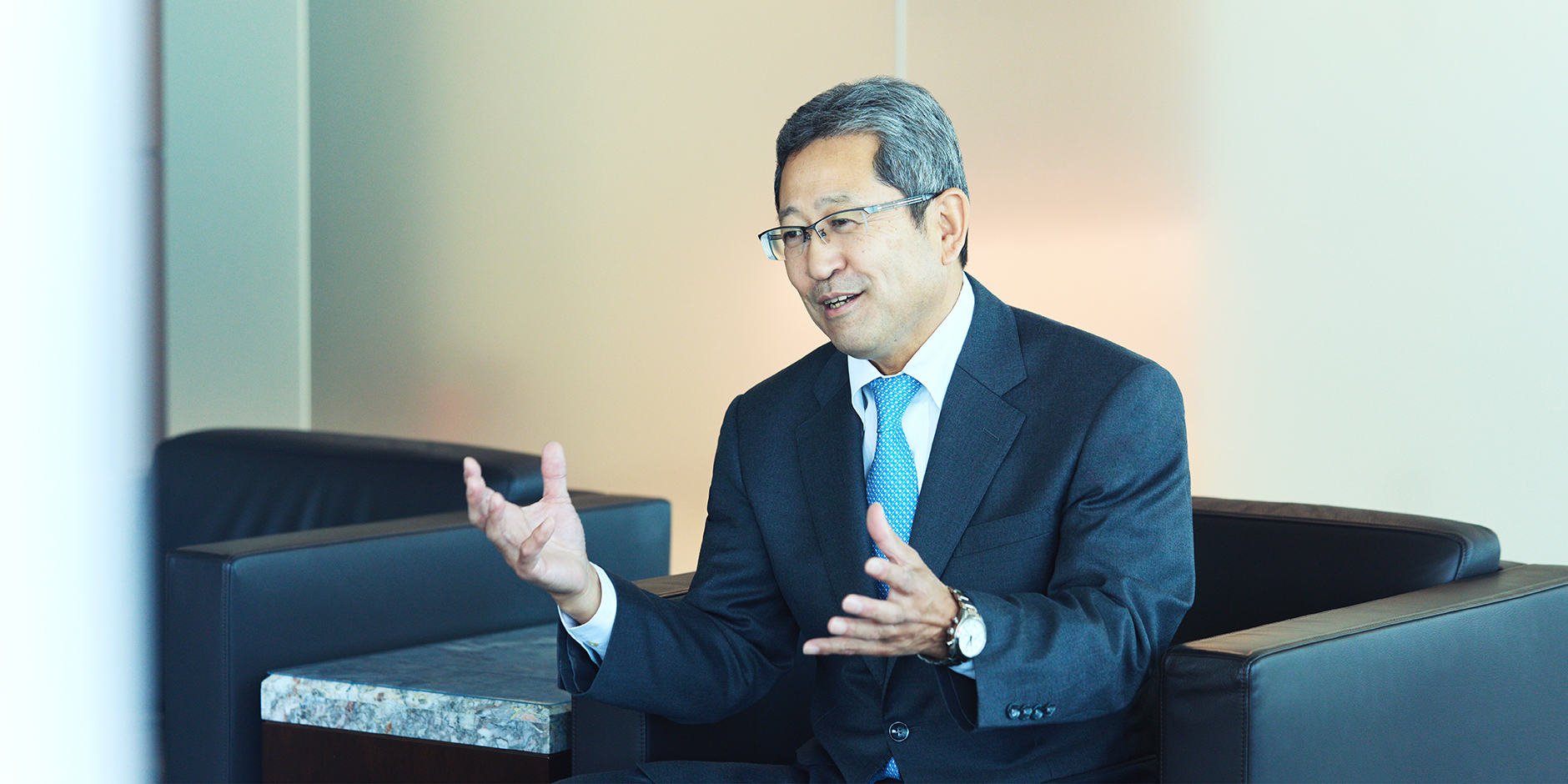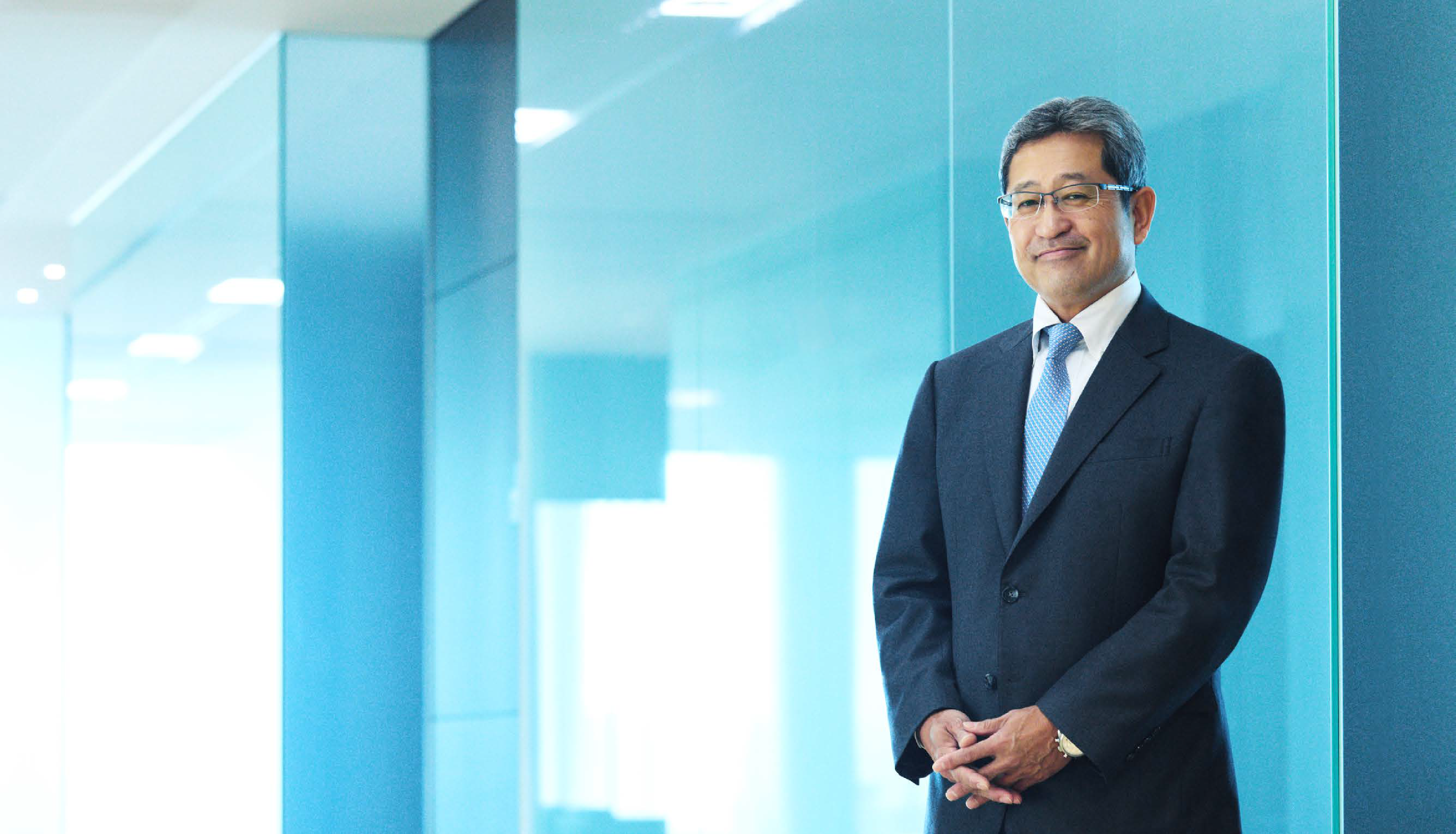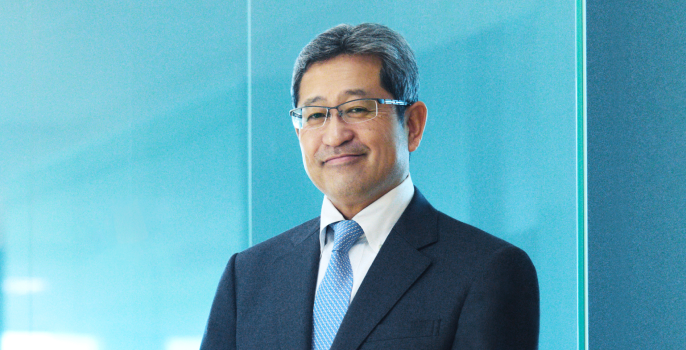Assumption of the position of President
To this end, in the spring of 2024 we implemented major changes to our leadership team consisting of executive directors and officers. This new team will focus on frontline capabilities and growth as we aim to dramatically improve our earning power.
Formulation of a new management vision and medium-term management plan
KAITEKI Vision 30 (KV30), which I was involved in formulating and announced in 2020, represented a clear vision for the Group in 2030 from a social and business perspective, by back-casting from our social vision for 2050. However, shortly after its implementation, we found that some of our key assumptions were unfolding faster than anticipated, such as more aggressive greenhouse gas (GHG) emissions reduction targets and the expansion of renewable energy. There were also unforeseen changes, such as the rise of AI and the pandemic’s impact on society. With the world seemingly on the verge of a major turning point, we began formulating a new management vision, tentatively called KAITEKI Vision 35 (KV35), and a new plan (hereafter referred to as the New Medium-Term Management Plan) will be announced in the fall of 2024.
While more details will be shared soon, the basic premise can be summarized as transforming ourselves into a green specialty chemical company that will realize KAITEKI. While promoting a shift to high-performance materials, the new plan also aims to redefine our objectives within the larger framework of KAITEKI and environmental sustainability.

Business portfolio strategy of selection and concentration
Specialty Materials:
Focusing resources on areas of strength
This segment deals with high-performance materials and is a major pillar of our future growth strategy. However, looking at current business performance, profit margins are generally lower than those of competitors, and both revenue and profit growth are lagging. We believe this is largely due to vast investment strategies made in the past. The key is to concentrate resources on the areas where we excel and to ensure more thorough portfolio management.
For businesses that do not play to our strengths, we have set time limits to assess their viability and will consider selling or withdrawing from them. We will use those proceeds to invest in growth areas where we excel. For example, in the semiconductor industry, we will focus on synthetic quartz used in the silicon wafer manufacturing process, raw material polymers for photo resists, epoxy resins for encapsulants, high-purity chemicals, precision cleaning services for semiconductor equipment parts, and gallium nitride, which we expect to be the next-generation substrate. For the food industry, we offer a lineup of products such as Sugar Esters, vitamin E, and films for food packaging, which enable long-lasting food products and help reduce food loss. For EV and mobility applications, we acquired all shares of C.P.C. S.r.l., which specializes in the manufacture and distribution of automobile components crafted from carbon fiber reinforced plastic (CFRP), and are strengthening and expanding our supply chain by increasing capacity for battery materials. We will concentrate our investment in areas where we can demonstrate strength as well as improve market share and profitability, and then expand into peripheral areas.
In terms of how we are organized, we conducted a major reorganization in April 2024. The three subsegments of the Specialty Materials segment were renamed and reorganized into Advanced Films & Polymers, Advanced Solutions, and Advanced Composites & Shapes. We established a new headquarters for each and appointed three experienced executive officers as general managers. Under this new leadership, each with strong ties to the field, the Company will keep close watch on developments across a wide range of product areas and take prompt action when needed.
Industrial Gases and Pharma:
Exploring synergies with core businesses
Both of these segments are key drivers of the Group’s performance. Looking at the industrial gases business of Nippon Sanso Holdings Corporation, initiatives to create synergies are currently underperforming. However, the Industrial Gases segment contributes to carbon-neutrality (CN) goals by improving the efficiency of our customers’ manufacturing processes and energy needs in general, and its steady profit growth is promising. In addition, the market is keenly aware of the high quality of our gases and the total solutions we provide. Rapidus Corporation is planning to build a pilot line for a next-generation semiconductor plant in Chitose City, Hokkaido Prefecture, and our gases have been selected to supply the line.
Mitsubishi Tanabe Pharma Corporation’s pharma business, likewise, lacks synergies with the chemical business, but its ability to create new drugs is seen as an advantage both domestically and internationally. RADICAVA ORS® oral suspension for amyotrophic lateral sclerosis (ALS), which has been designated as an orphan drug in the United States, continues to enjoy strong sales. On the other hand, for the domestic pharmaceutical business, which accounts for the majority of sales and revenue, maintaining the current business setup is something we need to address in the future, in part due to Japan’s National Health Insurance drug price revisions. In order to create the next generation of RADICAVA ORS® products and achieve further growth, we will streamline our initiatives and formulate growth strategies across global markets.
MMA & Derivatives:
Demonstrating the strength of our No. 1 global market share
This is the only segment in the world with the No.1 global market share that employs three different production methods. Alpha technology, a proprietary manufacturing process using ethylene as a raw material, is overwhelmingly cost competitive and enables significant GHG emissions reductions.
The investment in a new U.S. plant in Louisiana, currently under consideration and amounting to several hundred billion yen, is important for the medium- to long-term growth of the MMA segment. As of July 2024, we are studying the project’s feasibility and intend to make a final decision soon.
Basic Materials & Polymers
Petrochemicals Subsegment: Accelerate restructuring towards green
In the petrochemical industry, the profit margins are rapidly deteriorating due to a widening supply–demand gap in the domestic market and large production increases by Chinese companies. In addition, we believe that there is a limit to what individual companies can do, given the enormous scale of resources required to realize CN and CE goals.
As stated in our “Forging the future” plan announced in fiscal 2021, the Group’s petrochemicals subsegment is expected to be spun off in the future, but this does not mean that CN and CE will be achieved by simply doing that. With many customers operating downstream in the supply chain, we are concerned that they will be seriously affected if we fail to convert our petrochemical business to a viable CN and CE business model. From the viewpoint of “greening” high-performance materials, which are located downstream within the Group, we believe in promoting the greening of our petrochemicals subsegment responsibly. For this purpose, collaboration and alignment with other companies are essential. We would like to promote CN and CE while cooperating vertically and horizontally.
The approach we envision is to form multiple platforms open to other companies. As the Japanese government aims to reduce GHG emissions by 46% in fiscal 2030 (compared with fiscal 2013), we need to accelerate this initiative in order to get CN- and CE-compliant production facilities up and running as soon as possible. We have already reached agreements with Asahi Kasei Corporation and Mitsui Chemicals Inc. to jointly study the conversion of naphtha crackers (ethylene production facilities) in western Japan, including raw fuel conversion, and have begun discussions on specific measures and optimal production systems for the future. In the Kashima area of Ibaraki Prefecture, we are constructing a chemical recycling facility jointly with ENEOS Corporation. These are areas in which Japanese chemical companies excel, and we see them as both a challenge and a great opportunity.
As for individual company initiatives, it is necessary to thoroughly implement cost reduction initiatives and negotiations around pricing to fundamentally improve profitability. This is an achievable goal. In fact, amid a severe business environment, we secured profitability in the fiscal year ended March 31, 2024, with the exception of the carbon products subsegment. I am confident that if we steadfastly follow through on what needs to be done, the petrochemicals subsegment will become profitable.
Carbon products subsegment: Decisively implementing
structural reforms to improve profitability
The carbon products subsegment, which handles coke and other raw materials for steelmaking, has been struggling due to soaring coking coal prices and sluggish demand overseas. Although selling the business has been the default course of action, it is imperative to first decisively implement structural reforms and reorganize the Company to eliminate losses. We are also actively working on creating added value for CE through recycling (carbon cycle) technology.
Better cash flow management and introduction of ROIC management

Toward a more open and powerful organizational culture
First, we need to dismantle what can be called a deductive-based system. This is a culture in which managers and others easily dismiss proposals and suggestions from employees, which in turn inhibits organizational vitality. Such a culture deprives employees of the ability to think independently and never question directives, thereby denying them the opportunity to grow.
Second, we need to increase motivation in the field. Lack of motivation not only dampens productivity but also can lead to accidents and other problems. We will review our personnel system, support the active participation of women, and create a work environment in which employees can work with enthusiasm, while emphasizing job satisfaction and career growth.
Third, employees will be encouraged to take more ownership of their work. When a sense of ownership is combined with a strong desire to “make the business into what it should be in 10 years,” one’s work becomes more than just a job. It develops into a sense of responsibility to leave the business in better shape for the next generation, as if we were handing over the baton. In our day-to-day work, wishful thinking, blind assumptions, and a lack of critical thinking and imagination have no place. We need to embrace an attitude that confronts the truth and faces reality. In order to achieve this kind of culture change, it is important to revitalize communication. I personally visit two domestic offices and one overseas office every month to engage in intimate dialogue. We will also continue to provide various opportunities at the head office, such as town hall meetings for all Group employees and lunch meetings in smaller groups.
For all stakeholders
The share price is a message from the market, and I am constantly monitoring its movements. We will mobilize the collective power of the Mitsubishi Chemical Group to transform it into a business entity that sustainably achieves profitable growth. I believe this will enable us to solidify the trust of our shareholders and investors over the medium and long term. Once again. I would like to ask for your continued support as we make a fresh start.
PROFILE
Manabu Chikumoto joined Mitsubishi Chemical Industries Limited (now Mitsubishi Chemical Corporation) in 1988, and since then he has worked mainly in the field of sales in the petrochemicals business. Several years of overseas business experience, notably two assignments in India, was a major defining point of his career. During his first assignment, Chikumoto was involved in the construction of a large-scale plant, and in his second assignment, he led the restructuring of the plant, which had become unprofitable. After returning to Japan, he headed the Corporate Strategy Department, where he was involved in the formulation of KAITEKI Vision 30 (KV30) and the planning and reform of various businesses. Chikumoto says that these experiences have influenced and molded him into who he is today. His timeless philosophy is to work hard in the field and listen to what the field has to say.



